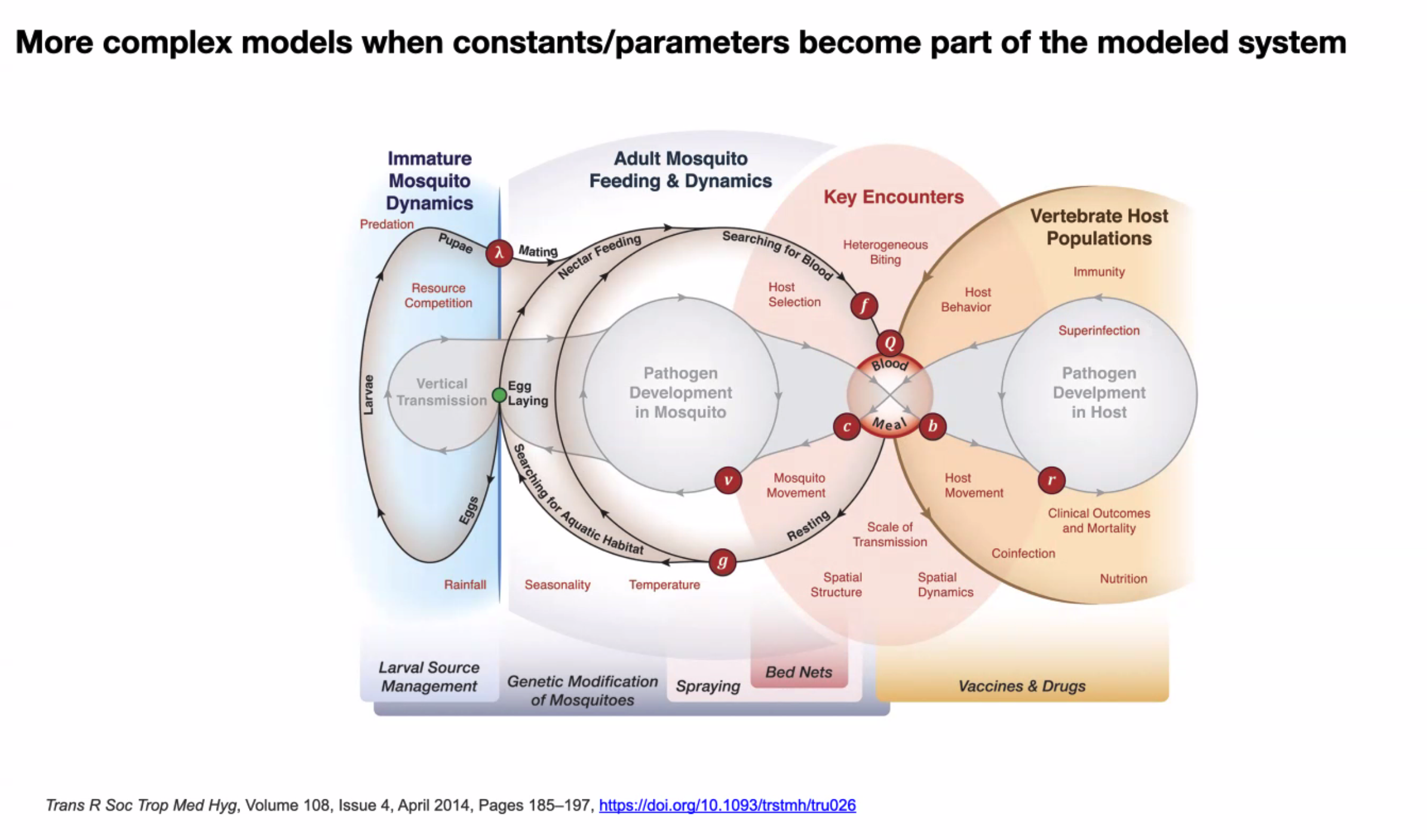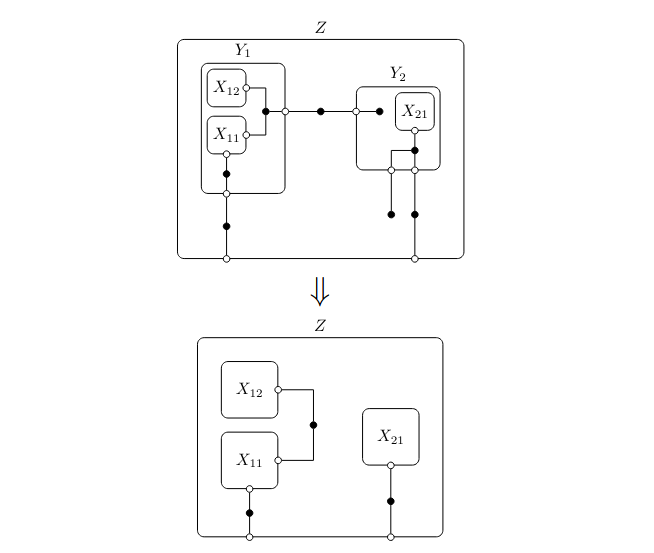collaborators = FileAttachment("collaborators.sema").text()
import { GraphApp } from "/main.js"
div = document.getElementById("collaborator-semagram")
GraphApp.main(div, collaborators)Computational Category Theory in Applied Mathematics
Owen Lynch and James Fairbanks
Overview
- Why is AlgebraicJulia?
- Who is AlgebraicJulia?
- What is AlgebraicJulia?
- How is AlgebraicJulia?
- Why again is AlgebraicJulia?
Part 1: Why is AlgebraicJulia?
Compositional modeling

Halter et al. (2020)
“Informal diagrams that should be String Diagrams”




The high-level picture

Part 2: Who is AlgebraicJulia?
History
- Evan Patterson started Catlab in 2017 to be a computer algebra system for applied category theory
- James Fairbanks started SemanticModels.jl in 2018 to achieve this “high-level modeling” dream
- In 2019, they started collaborating and created the AlgebraicJulia organization to maintain a variety of packages (often prefixed by “Algebraic”) around scientific modeling with applied category theory
- I joined in 2020 (the inflection point)
- Companies like Merck now hire based on “experience with AlgebraicJulia”
Collaborators
(made with Semagrams)
Part 3: What is AlgebraicJulia
The landscape of AlgebraicJulia
| Package | Description |
|---|---|
| Catlab.jl | Data structures, algorithms, visualization, computer algebra |
| AlgebraicDynamics.jl | Open dynamical systems |
| AlgebraicPetri.jl | Petri nets operations, including rate equation simulation |
| AlgebraicRewriting.jl | Rewriting systems for combinatorial data structures |
| AlgebraicRelations.jl | Database integration |
| CombinatorialSpaces.jl | Meshes for PDEs |
| Decapodes.jl | Discrete Exterior Calculus |
| StockFlow.jl | Stockflow diagrams and simulations |
| Semagrams.jl | User interfaces built around graphical syntax (Scala.js+Julia) |
Open dynamical systems overview
Libkind, Baas, Patterson, et al. (2022)
The math of open dynamical systems
(Vagner, Spivak, and Lerman (2015)) An open dynamical system consists of a state manifold \(X\), an input manifold \(X_{in}\), an output manifold \(X_{out}\), a readout function \(X \to X_{out}\) and an evolution function \(X \times X_{in} \to T X\).
Open dynamical systems form an operad algebra of the operad of undirected wiring diagrams.
Multiphysics
Patterson et al. (2022)

Conjugate heat transfer

Heat transfer between a solid and a fluid
Part 4: How is AlgebraicJulia?
What does it mean to “do category theory” on a computer?
The problem: pushouts in FinSet
In the category \(\mathsf{FinSet}\), the pushout of the above diagram is given by:
\[ X \sqcup_Z Y = (X + Y)/\sim \]
where \(\sim\) is the equivalence relation generated by \(f(z) \sim g(z)\) for all \(z \in Z\).
We want to actually compute pushouts!
FinSet in Julia
We first need to represent finite sets on the computer
A data structure for partitions
Julia has a data structure for representing a partition of \(\{1,\ldots,n\}\).
Pushouts in Julia
function pushout(X::FinSet, Y::FinSet, Z::FinSet,
f::FinFunction, g::FinFunction)
# Start with the singleton partition of {1,...,|X|+|Y|}
a = Partition(X.n + Y.n)
# Construct the partition we want: f(z) ~ g(z) for all z ∈ Z
for z in 1:Z.n
union!(a, f.values[z], g.values[z])
end
# Return a FinSet of size the number of unique roots
FinSet(length(unique!([find_root!(i) for i in 1:length(a)])))
endThis runs in time \(\mathcal{O}(m \log m)\), where m = X.n + Y.n.
Exercise: extend this code to also compute the legs of the cocone for pushout!
Part 5: Again, why is AlgebraicJulia?
Technical wins: data structures for free from C-sets
Patterson, Lynch, and Fairbanks (2022)



Technical wins: algorithms for free from limits/colimits
- Compute connected components for a graph by coequalizing src and tgt
- Split up a population in a Petri net by (age group/vaccination status/region/etc.) using limits (Libkind, Baas, Halter, et al. (2022))

Technical wins: algorithms for free from limits/colimits
- Compose structured cospans (c.f. Baez and Courser (2020)) of Petri nets

- Compose operations in the operad of (directed/undirected) wiring diagrams

Compositional modeling

Halter et al. (2020)
The Future of AlgebraicJulia
- Deliver high-quality results for individual domain-specific grants.
- Along the way, carefully develop and refine general-purpose open-source tools for scientists solving the world’s problems.
| Domain | Funders and Collaborators |
|---|---|
| Epidemiology | ASKEM DARPA Project, University of Saskatchewan, DARPA YFA award (PI: Fairbanks) |
| Multiphysics | ASKEM DARPA Project |
| Task modeling and planning | PTG DARPA Project |
| Industrial process and data management | CMU, NIST, Chevron |
| Compositional statistical modeling | AFOSR YIP award (PI: Patterson) |
| Education and outreach | Mozilla |
What can you do…
…if you will be on the job market soon:
Topos Institute and James’s lab at University of Florida are growing and will be looking for researchers over the next couple years. There may not be positions lining up precisely with the timing of when you are looking, but keep in touch with us if this is something you are interested in.
…if you want to use AlgebraicJulia?
Read papers and blog posts on algebraicjulia.org, and then ask us questions in the Julia Zulip: julialang.zulipchat.com.
…if you want to make your math be useful for scientists?
There’s no magic bullet, but the two things that will help are
- Keeping the end goal in mind: category theory as UI for high-level formal scientific modeling
- Talking to us (the AlgebraicJulia crew) about your research!
References
Baez, John C., and Kenny Courser. 2020. “Structured Cospans.” arXiv. https://doi.org/10.48550/arXiv.1911.04630.
Brown, Kristopher, Tyler Hanks, and James Fairbanks. 2022. “Compositional Exploration of Combinatorial Scientific Models.” arXiv. https://doi.org/10.48550/arXiv.2206.08755.
Halter, Micah, Evan Patterson, Andrew Baas, and James Fairbanks. 2020. “Compositional Scientific Computing with Catlab and SemanticModels.” arXiv. https://doi.org/10.48550/arXiv.2005.04831.
Libkind, Sophie, Andrew Baas, Micah Halter, Evan Patterson, and James Fairbanks. 2022. “An Algebraic Framework for Structured Epidemic Modeling.” Philosophical Transactions of the Royal Society A: Mathematical, Physical and Engineering Sciences 380 (2233): 20210309. https://doi.org/10.1098/rsta.2021.0309.
Libkind, Sophie, Andrew Baas, Evan Patterson, and James Fairbanks. 2022. “Operadic Modeling of Dynamical Systems: Mathematics and Computation.” Electronic Proceedings in Theoretical Computer Science 372 (November): 192–206. https://doi.org/10.4204/EPTCS.372.14.
Patterson, Evan, Andrew Baas, Timothy Hosgood, and James Fairbanks. 2022. “A Diagrammatic View of Differential Equations in Physics.” Mathematics in Engineering 5 (2): 1–59. https://doi.org/10.3934/mine.2023036.
Patterson, Evan, Owen Lynch, and James Fairbanks. 2022. “Categorical Data Structures for Technical Computing.” Compositionality 4 (December): 5. https://doi.org/10.32408/compositionality-4-5.
Vagner, Dmitry, David I. Spivak, and Eugene Lerman. 2015. “Algebras of Open Dynamical Systems on the Operad of Wiring Diagrams.” arXiv. https://doi.org/10.48550/arXiv.1408.1598.

Computational Category Theory in Applied Mathematics